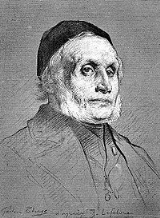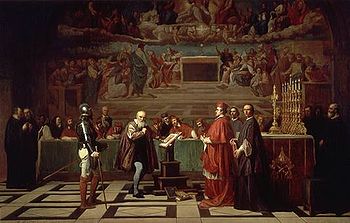
Joseph-Nicolas Robert-Fleury
Encyclopedia

France
The French Republic , The French Republic , The French Republic , (commonly known as France , is a unitary semi-presidential republic in Western Europe with several overseas territories and islands located on other continents and in the Indian, Pacific, and Atlantic oceans. Metropolitan France...
painter
Painting
Painting is the practice of applying paint, pigment, color or other medium to a surface . The application of the medium is commonly applied to the base with a brush but other objects can be used. In art, the term painting describes both the act and the result of the action. However, painting is...
.
Born in Cologne
Cologne
Cologne is Germany's fourth-largest city , and is the largest city both in the Germany Federal State of North Rhine-Westphalia and within the Rhine-Ruhr Metropolitan Area, one of the major European metropolitan areas with more than ten million inhabitants.Cologne is located on both sides of the...
, he was sent by his family to Paris
Paris
Paris is the capital and largest city in France, situated on the river Seine, in northern France, at the heart of the Île-de-France region...
, and after travelling in Italy returned to France and made his first appearance at the Salon
Paris Salon
The Salon , or rarely Paris Salon , beginning in 1725 was the official art exhibition of the Académie des Beaux-Arts in Paris, France. Between 1748–1890 it was the greatest annual or biannual art event in the Western world...
in 1824; his reputation, however, was not established until three years later, when he exhibited Tasso
Torquato Tasso
Torquato Tasso was an Italian poet of the 16th century, best known for his poem La Gerusalemme liberata , in which he depicts a highly imaginative version of the combats between Christians and Muslims at the end of the First Crusade, during the siege of Jerusalem...
at the Convent of Saint Onophrius.
Endowed with a vigorous original talent, and with a vivid imagination, especially for the tragic incidents of history, he soon rose to fame, and in 1850 succeeded François Granet as member of the Académie des Beaux-Arts
Académie des beaux-arts
The Académie des Beaux-Arts is a French learned society. It is one of the five academies of the Institut de France.It was created in 1795 as the merger of the:* Académie de peinture et de sculpture...
. In 1855, he was appointed professor and in 1863 director of the École des Beaux-Arts
École des Beaux-Arts
École des Beaux-Arts refers to a number of influential art schools in France. The most famous is the École nationale supérieure des Beaux-Arts, now located on the left bank in Paris, across the Seine from the Louvre, in the 6th arrondissement. The school has a history spanning more than 350 years,...
, and in the following year he went to Rome
Rome
Rome is the capital of Italy and the country's largest and most populated city and comune, with over 2.7 million residents in . The city is located in the central-western portion of the Italian Peninsula, on the Tiber River within the Lazio region of Italy.Rome's history spans two and a half...
as director of the French Academy in that city.
His son, Tony Robert-Fleury
Tony Robert-Fleury
Tony Robert-Fleury was a French painter.He was born just outside Paris, and studied under his father Joseph-Nicolas Robert-Fleury and under Delaroche and Léon Cogniet....
, was also a painter.
Selected works
- A Reading at Mme. de Sévigné's, Scene of St Bartholomew, Henry IV taken to the Louvre after his Assassination (1836)
- Triumphal Entry of Clovis at Tours (1838), at the Versailles Museum
- Le Colloque de Poissy (1840), at the Luxembourg MuseumMusée du LuxembourgMusée du Luxembourg is a museum in Paris, France. It occupies the east wing of the Palais du Luxembourg, whose matching west wing originally housed Ruben's Marie de' Medici cycle. Since 2000 it has been run by the French Ministry of Culture and the Senate and is devoted to temporary exhibitions...
in Paris - The Children of Louis XVI in the Temple (1840)
- Marino Faliero
- An Autodafé
- Galileo before the Holy Office, at the Luxembourg Museum
- Christopher Columbus received by the Spanish Court (1847), Musée du Luxembourg
- The Last Moments of Montaigne (1853) and Charles V in the Monastery of Yuste (1857).
The reception of Christopher Columbus by King Ferdinand II and Queen Isabella of Spain in Barcelona(1846)

